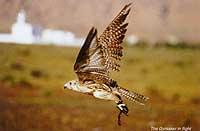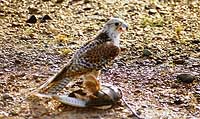
|

The falcon flies low, almost beneath the wind that blows in a steady stream across the coarse desert plain. It bobs and feints as though teetering on a wire before shooting high into the air with a sudden, steep climb. The lure has been thrown. Rising above it, the falcon stalls and plummets straight down, snatching the bait mid-air with an audible crack. By the end of the hunting season, which runs October to February, a falcon will be flying to the lure like this as many as fifteen times a day. Now it is mid-April and we are lucky to have found someone prepared to fly a falcon at this time of year. If the birds have not already been released back into the wild to resume their migratory journey, they will be recuperating in captivity out of the heat, moulting and readying to breed. Dan Daman is a respected trainer and breeder of falcons from Belgium, who, for nearly three years, has been living a love affair with the falcon and other birds of prey of the Gulf in the peaceful oasis town of Al Ain. His falcon is a Gyrsaker Falcon, a male, nearly two years old. It is a hybrid of two of the most revered species of falcon, being the Gyr, native to the Arctic, appreciated for its size and proud frame, and the Saker, locally prized for its aggression, stamina and endurance of the heat. Although the Peregrine Falcon is the best known and most widely occurring around the globe, the classic bird of Arab falconry is the Saker. Courageous and well-adapted to the desert environment, the local name for the best Saker is hurr, meaning noble or free. 
Native to eastern Europe, across Asia and into China, these compact falcons are valued for their versatility in catching the legendary Houbara Bustard, a wily, aggressive bird which feeds at night and conceals itself in the desert undergrowth, perfectly camouflaged, to sleep during the day. Its cunning character has made the Houbara the most sought after quarry of the Arab falconer. The Houbara is a match in size and strength to the Saker, so the aerobatic dogfights of their battles have captivated the desert nomads for generations. The Saker and Houbara are destined as enemies from birth. Their rivalry is the cornerstone of Arab falconry. Arab falconers are preserving a tradition that goes back to another epoch, when survival in the harsh desert terrain was a daily battle. The nomads would capture falcons as they passed through the Gulf during their autumn migration from Eurasia to wintering grounds in Africa. The bedu would train their captured raptors for about two months until the pair were ready to hunt for food. The relationship was perfectly utilitarian. The nomad flew his falcon because he wanted to eat; he did not go hunting because he wanted to see the falcon fly. When the various bird species which were the quarry of the hunt had completed their passage over the desert, the falcons would be released to continue their own migration, as there was no longer any reason to keep them. Today falconry survives as a sport, an enjoyable drama. The process of training and flying the birds is now the essence of modern falconry, not the prey. The activity has evolved into an important social event, a meeting place for friends and figures in the community, a chance to escape the daily pressures of urban life. Outside the Emirates, falconry has brought schools, mosques and investment to impoverished regions where the Houbara is still quite plentiful, such as rural Morocco and Pakistan. But, above all, falconry is still practised by the Arab people as a mark of respect to the survival of their forefathers in the desert. As David Remple, head veterinarian at the Dubai Falcon Hospital and author of a book on falconry in the Gulf, explains: "The Arabs now fly falcons because they enjoy it, because it's fun; but they are also upholding a part of their heritage that could go back as far as two and a half thousand years." Nowadays, in the interests of conservation and research, more falcons are bred and trained in captivity than are caught in the wild. Such raptors are kept the whole year round, utilising modern techniques. This is where Dan, expert and guide for the day, comes in. 
It is a fine line between raising a falcon tame enough to be controlled yet wild enough to retain its natural killer instinct. Dan calls it "the will to kill." The falcon being trained must eventually be released to fly free in order to allow it to develop natural instincts and awareness. The first release, however, is always a terrible moment of suspense for any trainer. "You're always scared that it might not come back," says Dan. "Once out in the desert I lost a young falcon as night was falling. I couldn't leave because I had no way of returning to exactly the same spot. I spent two whole days waiting for it to return, but it never did." Falcons kept captive are prone to ill health, particularly during the blowtorch summer months. A young, well conditioned falcon can fetch 50,000 Dh, so there is more than a little incentive to keep it fighting fit. Aspergillosis, a potentially fatal fungal infection which primarily affects the respiratory system, and Bumblefoot, an infection afflicting the soles of the feet, are common ailments. In 1983, Dr Remple was invited by His Highness Sheikh Hamdan bin Rashid al Maktoum to found the Dubai Falcon Hospital. This facility was the first of its kind in the Middle East and set a benchmark for the care and treatment of falcons. From an initial caseload of two hundred falcons a year, Dr Remple and his team are now treating more than two thousand birds a year. "It's not that there are more falcons falling sick," he says. "Local falconers are instead appreciating the value of what we do here." Falconry in the 90s has gone high tech. A microchip is implanted into the bird's chest from which the entire medical record can be accessed. Radio transmitters are also commonly fitted to monitor its flight in order to supplement an ever-increasing body of international research. Dan Daman, for his part, is conducting his own research project, donning the cap of inventor as well as trainer to find a new treatment for the crippling Bumblefoot infection. A curious stainless steel object stands in one of the work rooms at his home, looking like a science project that went sadly wrong. "But it works!" he assured me as he excitedly explained his breakthrough. Conservation of wildlife is becoming an ever more pressing issue, so a greater understanding of the delicate environment in which the falconer functions is invaluable. If the local ecology is disrupted beyond repair, then the noble tradition of Arab falconry will vanish with it. Already the Houbara has almost been hunted to extinction in the Emirates. It is for this reason that His Highness Sheikh Khalifa bin Zayed al Nahyan established by Royal Decree in 1989 the National Avian Research Centre. Dedicated to the sustainable use of wildlife, NARC has pioneered captive breeding of the Houbara Bustard by artificial insemination. By using satellite telemetry, the UAE has become the first country in the world to track successfully the migration route of the Hobbara. Technology means a brighter future for Arab falconry, aligned with common sense. NARC's press officer is Theresa Baily. "We are promoting a very practical philosophy, that the true falconer is not the man with the largest bag at the end of day, but the man who has shown enough wisdom to leave some for tomorrow." Out in the desert, Dan would agree. He has flown his falcon for the last time. It is on the ground, shrouding its wings over the lure just as it would protect its prey from rivals. Dan looks off at the sun nudging its way towards the horizon. "They're noble creatures," he says, "proud until the end. Even when they're ill you can't really tell, except from the eyes. You can learn a lot from them - patience, tolerance. It's funny, but I know I've learned more from them than they from me." |